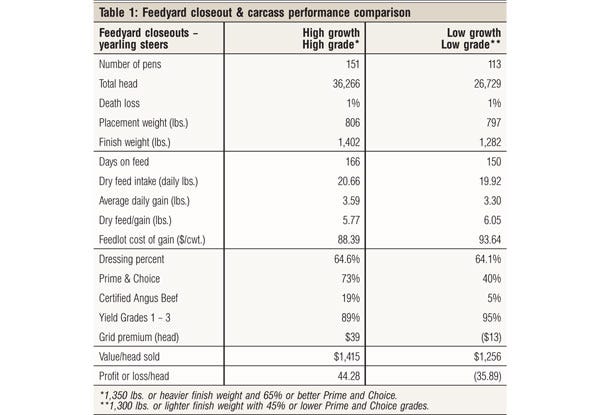Cattle that grow and grade are exactly what feedyards want, says the world’s largest cattle feeder.
August 22, 2012

The purpose of this article is to highlight the exceptional value and profit potential created by cattle that grow fast and grade well. Cattle that grow and grade are winners at all points along the beef supply chain. Feedyard managers and packers really like these cattle, and will bid aggressively to get them.
Why? Because cattle that grow and grade are excellent performers in the feedyard and go on to create sizable premiums when sold on a carcass-merit grid. That’s a double benefit which adds real dollars to the bottom line.
Every cow-calf producer who desires top dollar for his/her calf crop would do well to incorporate both rapid growth and high quality-grading potential into each calf crop. Rapid growth and strong marbling genetics make cattle worth more to everyone who owns them.

To illustrate this point, the table above compares two sizable groups of yearling-fed steers placed on feed weighing about 800 lbs. The first group represents 151 pens (36,266 head) that weighed 1,350 lbs. or heavier when leaving the feedyard and graded 65% Prime and Choice or higher at the packing plant. These cattle are appropriately labeled high-growth, high-grade (HGG).
The second group is comprised of 113 pens (26,729 head) that finished lighter and graded lower. These steers finished below 1,300 lbs., graded 45% or less Prime and Choice, and can be aptly identified as low-growth, low grade (LGG) cattle.
Both groups were fed in the same Five Rivers feedyards, managed the same from placement to finish, and marketed during the same period of the year. Thus, most of the difference between how these two groups performed is the result of genetics.
The HGG cattle did exactly what they were genetically programmed to do, posting excellent results in the process. The LGGcattle also expressed their lower-performance genetics via slower growth, lower quality grades, and a poor financial outcome.
The HGG cattle were undoubtedly produced by people who care a great deal about the genetics they build into their cowherds. High-quality Angus bulls, emphasizing post-weaning growth and marbling ability, represent a sizable portion of their genetic inputs. The carcass profile of these cattle alone is evidence of that.
Key performance categories
Let’s look at how these two groups of cattle compare in key performance categories.
Feedyard results
Days on feed: HGG steers stayed on feed 16 days longer. This is because they kept eating and had the genetic propensity to continue growing efficiently and reach a heavier finish weight. Feedyards appreciate this characteristic, especially when feeder cattle numbers are in as small supply as they are currently.
Dry feed intake: High-performance cattle tend to eat more feed on a daily basis. This is what we observed with the HGG group, which consumed 0.75 lb./head/day more than the LGG group. Eating more feed, above that needed for daily body maintenance, leaves more energy available for growth.
Average daily gain: HGG cattle outgained their lower-performing counterparts by 0.29 lb./day (8.7%) over the entire length of the feeding period.
Dry feed to gain: Also known as feed efficiency or feed conversion, the HGG group achieved a 5% advantage, which not only saves money in an era of high feed costs, but identifies them as better stewards of the high-priced feed they consumed.
Cost of gain: Cattle that gain fast and efficiently in the feedyard will have favorably low cost of gains. The HGG cattle beat their lower-performing peers by more than $5/cwt. of live weight gain (6%). Cattle with lower gain costs are simply more profitable to feed, in this case producing a $25-$30/head feed-savings advantage over the LGG group.
Carcass results
Dressing percent: Because value-based grids pay on a carcass weight basis, carcass weight as a percentage of live weight is important. HGGsteers had higher carcass yields as a percentage of their live weight by 0.5 percentage points as compared to LGGcattle.
Quality grade: Large differences in marbling and quality grade translate into big differences in value. More Prime and Choice, as well as more brand-beef qualifying carcasses give the HGG cattle a sizable economic advantage and make cattle feeders, packers and beef consumers happier in the process.
Yield grade: This is the only place the LGG group has a notable advantage (fewer Yield Grade 4s and 5s). Yield grades are important, but the resulting value benefit is fairly small compared to the disadvantage of fewer pounds and lower quality grades also seen in the LGG group.
Grid premium: Steers falling into the HGG classification beat the average market price by $39/head. In contrast, LGG steers were discounted by $13/head below the average market price. Total difference in grid premiums/discounts between the two groups added up to a whopping $52/head.
More total value, more profit
Greater top-line revenue and more profit is what the HGG group accomplished. Their total value was $159/head higher than the LGG steers. They grew faster and more efficiently, with lower cost of gain. They also produced more valuable carcasses and captured more brand-qualifying premiums, like those available on Certified Angus Beef®.
However, the good news does not stop there. The HGG cattle were more profitable by $80/head! Half of the additional top-line value they created worked its way right into bottom-line profits. That’s an excellent result. Every feedlot manager in the business will take as many of those type cattle as they can get.
Tom Brink is president and chief operation officer for J & F Oklahoma Holdings, Inc.
You May Also Like



